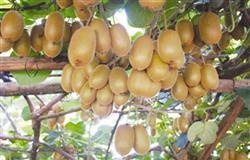Occurrence regularity and control of Botrytis cinerea in kiwifruit

Botrytis cinerea of kiwifruit mainly occurred in flowering stage, young fruit stage and storage period of rhesus monkey. In severe years, the incidence of orchard and storage period can reach more than 50%. Botrytis cinerea has become one of the main diseases affecting the healthy development of kiwifruit industry. 1. When the symptom young fruit (from the end of May to the beginning of June) occurs, there are dense gray spores on the remaining stamens and petals. At the first occurrence, the hairs of the young fruit turn brown, and the pericarp is infected, which can cause fruit drop in severe cases. The bacteria-carrying stamens and petals are attached to the leaves and take this as the center to form a ring-like disease spot, the disease spot expands, and the leaf falls off. In the case of Rain Water, the disease occurs more seriously. After the fruit was damaged, grayish-brown hyphae and spores were formed on the surface, and then black sclerotia were formed. The fruit is easy to be infected by diseased fruit during storage. Second, the occurrence regularity of the bacteria overwintered with sclerotia and conidia in the diseased tissues such as fruits, leaves, flowers and so on. From the beginning of the second year to the last flowering stage, under the condition of rainfall or high humidity, the pathogen infected the flower organ and caused flower rot, the bacterial petals fell on the leaves and caused leaf spots, and the bacterial petals remaining in the young fruit pedicel invaded the pulp from the pedicel wound, causing fruit rot. The growth and development temperature of the pathogen was 0-30 ℃, and the optimum temperature was about 20 ℃. Compared with the soft rot of fruit, the pathogen of Botrytis cinerea grew vigorously at the temperature below 20 ℃. Therefore, Botrytis cinerea occurs more frequently at low temperature, and the pathogenic bacteria are easy to form spores under the condition of high air humidity and spread with wind and rain. Third, prevention and control methods 1, agricultural control 1) carry out ridge cultivation, pay attention to orchard drainage and avoid close planting. Good ventilation and light transmission and suitable humidity conditions are the most basic requirements of orchard management. Pay attention to remove all kinds of plant remains and crop straw in and around the garden in autumn and winter, and avoid using wooden piles as a frame as far as possible. 2) prevent the branches from growing, cut the branches in summer, increase the ventilation and light, and reduce the humidity in the garden. The density of the canopy is in the shape of a sieve hole when sunlight is projected into the ground gap. 2. Chemical control 1) pre-harvest control. Start spraying fungicides before flowering, such as 50% Sukeling wettable powder, 1000 times spray wettable powder, 1500 times ethylene sclerotiorum wettable powder, 50% prohydantoin wettable powder, etc. Spray every 7 days, 2-3 times in a row. After summer shearing, spray protective fungicides or biological agents. 2) postharvest control. Spray fungicide once a week before harvest. Fruit picking should avoid and reduce fruit injury, avoid fruit picking in cloudy and rainy days and wet dew. Remove the diseased fruit and prevent secondary infection. After entering the warehouse, the pre-cooling time should be prolonged appropriately. Try to reduce the humidity of the fruit, and then pack and store it.
- Prev

Cultivation and management techniques of kiwifruit after autumn
It is very important to apply base fertilizer in combination with ploughing and weeding after fruit harvest in autumn. the amount of fertilizer application accounts for 60%-70% of the annual fertilizer application. Early application of base fertilizer can restore the tree potential as soon as possible, which is beneficial to the tree overwintering and ensure the fruit of the coming year. Base fertilizer is commonly used as rotten farm manure. Generally, 1500-2000 kg of farm manure is applied per mu, and 3000-500 kg per mu of adult orchard.
- Next

High-yield techniques of kiwifruit
First, varieties should be selected with large fruit shape, good quality, strong disease resistance and good yield, such as Hayward, Allison, Bruno and so on. Second, choose to build kiwifruit garden in a cool and humid environment, afraid of drought, waterlogging, wind and cold, but not resistant to the late frost of early spring, so mountain kiwifruit orchards should be chosen in the leeward.
Related
- Moge, come on! The staff of the peasant association in the producing area of cantaloupe were frightened when the crowd gathered.
- Causes and Solutions of low Fruit setting rate of Apple
- Symptoms and control measures of passion fruit virus disease
- Fruit growing lesson: how do apple orchards keep high yields?
- Can you build orchards in the mountains? What are the pros and cons?
- How to manage the coloring period of Crisson grape?
- This paper introduces the processing technology of two kinds of fig products.
- How much is a month for retired teachers in rural areas by 2020?
- How can strawberry planting increase sugar content? We should pay attention to management in many aspects.
- What are the cultivation techniques on how to improve the yield of golden fruit?

